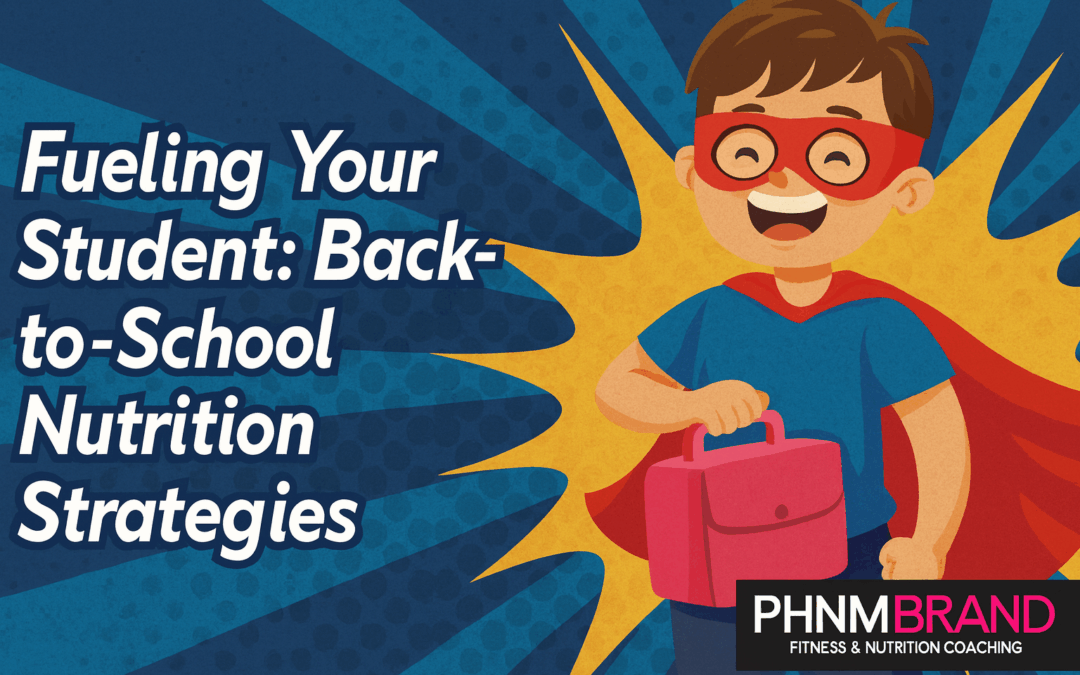Fueling Your Student: Back-to-School Nutrition Strategies for Focus, Energy, and Growth
The Summer-to-School Shift
When summer fades and school starts back, kids swap lazy mornings and flexible meal times for early alarms, packed schedules, and long stretches between meals. The shift can be a challenge…not just for them, but for you as a parent.
One of the most important ways you can help your child adjust? Nutrition. What they eat (and how consistently they eat it) impacts their energy, focus, mood, and even their confidence. But here’s the truth many parents overlook: kids don’t just follow instructions, they follow examples.
If they see you skipping breakfast, grabbing fast food between errands, or mindlessly snacking in front of the TV, they’ll assume that’s “normal.” If they see you sitting down to a balanced breakfast, packing a healthy lunch for yourself, and keeping a water bottle handy, they’ll see healthy eating as just part of life.
Back-to-school nutrition isn’t just about packing their lunch… it’s about living the habits you want them to copy.
1. Start with a Strong Breakfast
Why it matters: A protein-rich breakfast helps stabilize blood sugar, improves focus, and supports a better mood throughout the morning.
The trap: Cereal, toaster pastries, and sugary muffins give a quick boost followed by a crash before 10 AM.
Better options:
-
Protein smoothie with fruit and spinach
-
Egg muffins with veggies and cheese
-
Greek yogurt with berries and nuts
-
Overnight oats with added protein powder
Model it: Sit down with your child and eat breakfast with them, even if it’s quick. If you’re in a rush, grab the same smoothie they’re having and head out the door together.
2. Pack a Smart Lunchbox
The 3-part formula: Protein + Produce + Quality Carb.
Ideas kids actually eat:
-
Turkey & cheese roll-ups, baby carrots, whole-grain crackers
-
Hummus, pita bread, cucumber slices, boiled egg
-
Leftover chicken & veggie wrap
-
Mini bento box with grapes, cheese cubes, pretzels, and almonds
Model it: If you’re heading to work, pack yourself a similar lunch. It’s a small action that sends a big message, “this is how we fuel our bodies for the day.”
3. Rethink After-School Snacks
The problem: Kids get home starving and reach for chips, cookies, or soda.
Better snack swaps:
-
Apple slices with peanut butter
-
Cheese sticks & grapes
-
Trail mix with nuts, seeds, and a few dark chocolate chips
-
For sports days: protein + carbs (e.g., turkey wrap, banana with nut butter)
Model it: Keep your own after-work snacks healthy, too. If you’re reaching for water and trail mix, they’ll be more likely to do the same.
4. Hydration Habits
Even mild dehydration can hurt focus and mood.
Tips:
-
Have your child keep a water bottle in their backpack and refill it before lunch.
-
Limit sugary drinks to occasional treats.
-
Sports drinks are only needed for intense, long-duration activity.
Model it: Carry your own water bottle and sip throughout the day. Kids notice.
5. Brain Fuel Foods
Certain nutrients directly support learning and memory:
-
Omega-3s (salmon, chia seeds, walnuts)
-
Complex carbs (oats, whole-grain bread, quinoa)
-
Lean proteins (chicken, turkey, eggs, Greek yogurt)
Mix these into breakfasts, lunches, and snacks so your child is fueling both their body and their brain.
6. Make It a Routine
Healthy eating is easier when it’s predictable:
-
Plan and prep on Sundays.
-
Involve your child in choosing and prepping snacks/lunch.
-
Keep healthy foods at eye level in the fridge and pantry.
And remember, consistency matters more than perfection. If your child sees you making healthy choices most of the time, they’ll understand that’s the standard, even if there’s room for flexibility.
Closing – Lead the Way
Good nutrition is one of the most powerful tools you can give your child for school success — not just for grades or sports, but for their mood, confidence, and long-term health. But the real magic happens when they see you doing it too.
Healthy habits aren’t taught through lectures, they’re caught through watching. If you want your child to eat better, drink more water, and prioritize movement, show them what that looks like in your own life.
Start small: eat breakfast together, pack your lunches side by side, and keep the pantry stocked with smart snacks. As the school year begins, be the example they can follow, and watch how much easier the change becomes for both of you.

